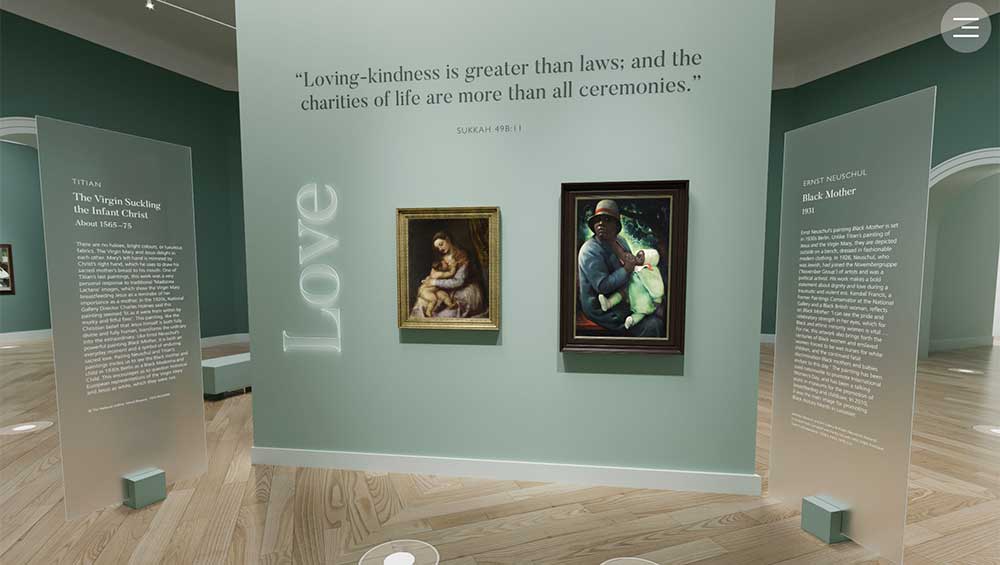
Fruits of the Spirit: Art from the Heart, virtual exhibition, The National Gallery, London. Screenshot, 16-01-2023.
The National Gallery, London
5 December 2022 – 30 April 2023
by ANNA McNAY
But the fruit of the Spirit is love, joy, peace, patience, kindness, generosity, faithfulness, gentleness and self-control. Against such things there is no law. [Galatians 5:22-23]
Two millennia ago, Paul wrote, in his letter to the Galatians, of these nine virtues by which a Christian would live, were he living with the Holy Spirit in his life. Paul used the singular “fruit” to describe these qualities since, for him, no single one could stand alone, each one enriching and furthering the others. In our current state, with war raging in Ukraine, Syria, Iraq and many other countries worldwide; the Covid-19 pandemic still taking countless lives; poverty affecting more than one in five people here in the UK alone; and climate change engendering catastrophe across the globe, these nine attributes are no less relevant or desirable, and this holds not just for Christians, but for people of all creeds and convictions who wish to “live well”.
This seed was taken by the Rev Dr Ayla Lepine and nurtured into a fully grown virtual exhibition hosted by the National Gallery, via the platform Moyosa, in collaboration with nine museum partners across the UK. I am not a fan of virtual exhibitions because such an online experience is far from a real-life encounter in a gallery, whereby one is able to marvel at the scale, texture and tones of a painting – features that are altogether lost in a virtual rendering. Add to that my general plight as a Luddite, meaning that I struggle with these new-fangled sites, which supposedly allow you to move seamlessly about a gallery space. For some reason, I always end up in a corner looking at the floor, unable to navigate my way out of this conundrum. Moyosa is no exception, although the facility to click on an artwork and land square on in front of it is a saving grace. Nevertheless, I have required a fair amount of at least two of these fruits in the process of viewing.

Fruits of the Spirit: Art from the Heart, virtual exhibition, The National Gallery, London. Screenshot, 16-01-2023.
Of course, what an online exhibition can offer, which its real-life counterpart cannot, is the bringing together and showcasing of works of art from around the world that might otherwise be unable to travel or impossible to secure the loan of. At its heart, it is a fabulous way of putting together a well-illustrated book with accompanying essays by – and, of course, hyperlinks for – art and cultural historians, museums and galleries, and related content of an equally international variety, which would have been financially equally unviable in a real-world context. As Lepine writes in the introduction: “The catalogue features contributions from many voices across the UK. Differences in writing style, approach and points of view are a positive feature of this project, allowing each voice – from an artist working in a hospital to a teenage climate change activist walking through the Devon countryside – to be recognisably unique and authentic.” And under this critical spotlight, Fruits of the Spirit succeeds admirably – although, as is the nature of the beast with an exhibition drawn from such a potentially endless pool, there could be much quibbling over the chosen pairs of work, which others would doubtless have been better suited, and what the selection criteria were. Again, taking all that as a given, and judging the exhibition for what it offers as opposed to what it lacks, it is a simple concept that has been solidly rendered, which provides for an interesting comparison of a number of works and themes, and which might, if successful, entice “virtual visitors” to become “real-life visitors” to see the National Gallery’s own works in the flesh, or, if based elsewhere or travelling, to perhaps pick up some of the others in their itinerary. And its reach is, it goes without saying, international, free and accessible to anyone with internet access).
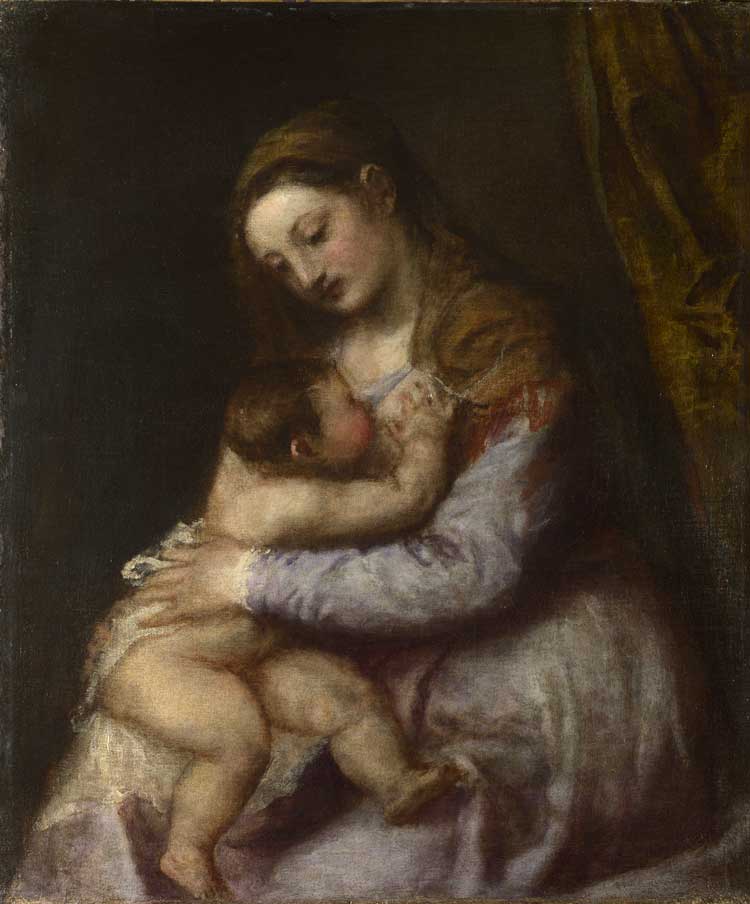
Titian, The Virgin Suckling the Infant Christ, about 1565-75. © The National Gallery, London.
To begin with love, for this is the key to all the other virtues, the National Gallery work chosen is one I know well and love: Titian’s The Virgin Suckling the Infant Christ (c1565-75). The scumbled surface and soft, unblended brush strokes evoke a tenderness and intimacy between mother and child, such that the painting, when it first arrived at the National Gallery, was catalogued not as an image of the Virgin Mary and Christ, but simply as Mother and Child. Today, however, it is understood as Titian’s very personal response to the genre of Madonna Lactans. The muted colours – although the pink lake glazes in the shadows of the lavender-grey dress have faded as a result of cleaning over the years – also suggest humility, and the historical uncertainty concerning the holiness or not of the subjects speaks to the Christian belief that Jesus is both divine and fully human. The ordinary is transformed into the extraordinary. One of his last works, this painting is very different from Titian’s highly polished earlier canvases, seeming almost to lean towards an impressionistic style. And this is perhaps fitting for the conjuring of an abstract quality such as love.
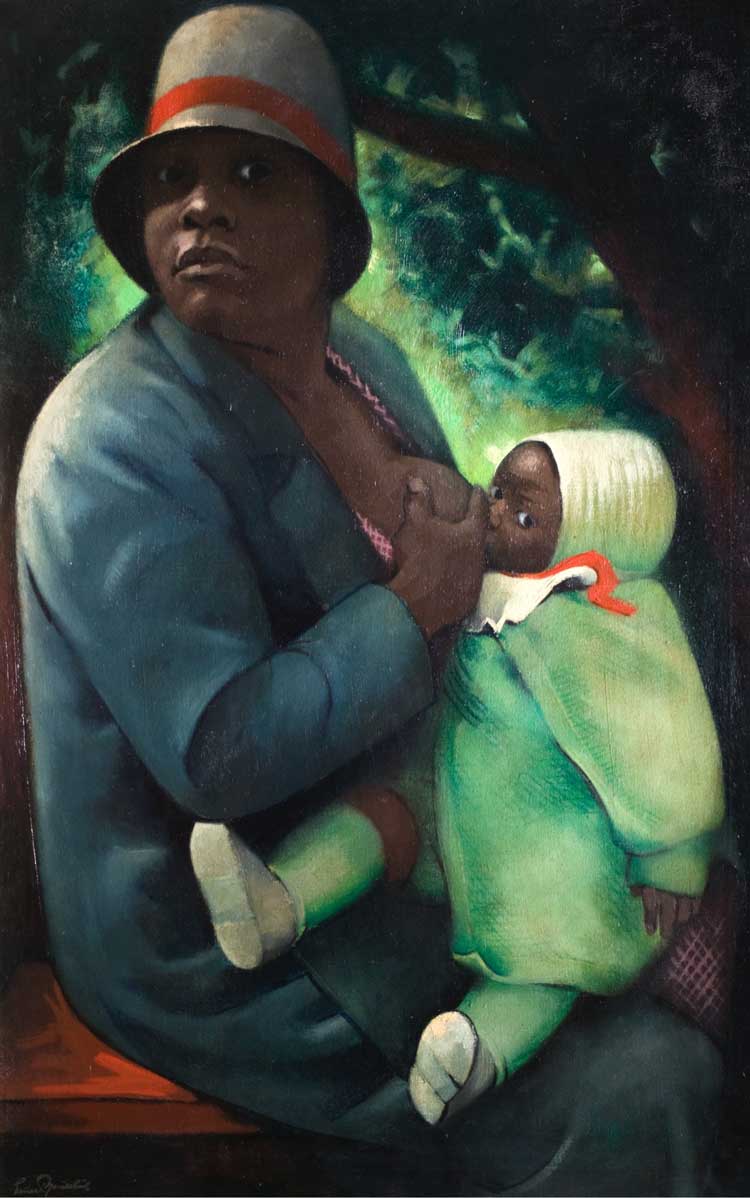
Ernst Neuschul, Black Mother, 1931. Oil on canvas, 100.5 x 65.5 cm. Leicester Museum & Art Gallery. Purchased from Campbell and Franks Ltd with MGC/V&A Purchase Grant Fund assistance.
The painting is paired with the Jewish artist Ernst Neuschul’s Black Mother (1931), made in Berlin at a time when the Nazi party was making significant gains and Jewish and black people were facing increasing persecution. Unlike in Titian’s painting, both mother and child (similarly in the process of breastfeeding) gaze out at the viewer – perhaps in defiance? Or is it fear? In 2010, this painting was used as the main image for promoting Black History Month in Leicester (where it is held in the Leicester Museum and Art Gallery collection). Of course, Jesus and Mary were not white, despite their usual depiction as such in European Christian imagery. Paired with Titian’s painting of the Madonna and Child, the latent comparison is made explicit, and beyond the many theological and sociopolitical discussions this engenders, so, too, does it compare two types of unconditional love: storge, the love between a mother (parent) and child, and agape, the transcendent love of Jesus/God for his people (as well as the reciprocal human love for God), considered, in the Scriptures, to be the highest form of love.
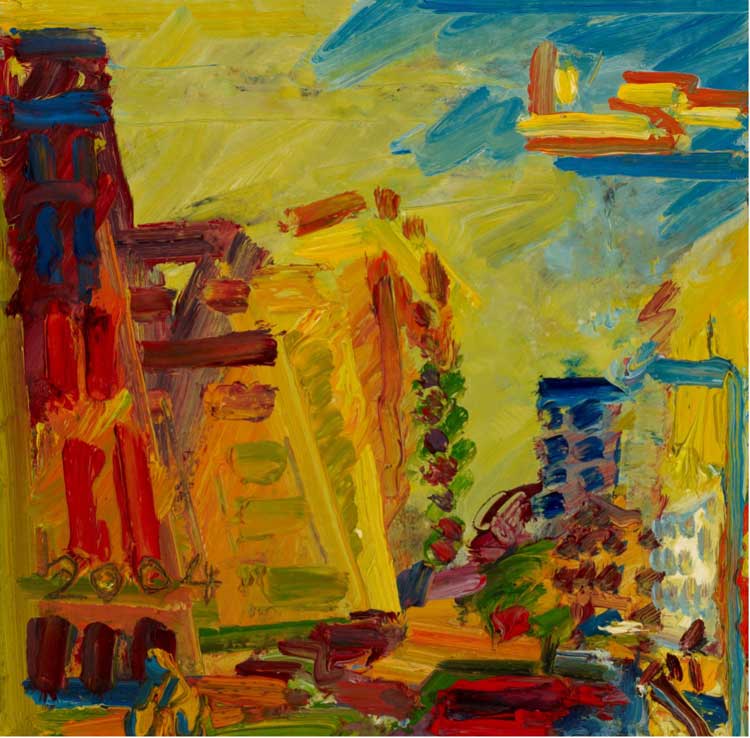
Frank Auerbach, Mornington Crescent, Summer Morning II, 2004. Oil on board, 51 x 51 cm. Ben Uri Collection. Acquired for the Ben Uri Collection in 2006 through the support and generosity of the Art Fund, MLA/V&A Purchase Grant Fund, Daniel and Pauline Auerbach, Frank Auerbach and Marlborough Fine Art London.
Joy is represented by two quite different paintings: Vincent van Gogh’s Sunflowers (1888) (from the National Gallery) and Frank Auerbach’s Mornington Crescent, Summer Morning II (2004) (from the Ben Uri Collection). What these two works have in common is the vibrant (and certainly very joyful) yellow that predominates in each. While Van Gogh might not seem the obvious choice to represent joy, as Lepine cites in her essay, he wrote on the subject in a letter to his brother Theo in 1876: “The joy of others may embitter jealous hearts, but it fortifies submissive hearts; it is the ray of sunshine that opens up those two lovely flowers called ‘confidence’ and ‘hope’.”1 Of course sunflowers are associated with the sun not only for their appearance but for their heliotropism.
Auerbach’s dynamic cityscape, painted impasto in the primary colours (unlike his early much more monotone canvases), takes what could be a drab subject and renders it full to bursting with joie de vivre. The dabs of thick paint, applied with the end of a brush, or, perhaps, a finger (a prime example of when a virtual encounter with the painting leaves me unfulfilled and yearning to study its texture up close and in person), come together in an abstract symphony of playfulness, furthered by the scratching in of the date in large figures to the bottom left. The experience of viewing the work (even on a small screen) cannot help but elicit joy. For both artists, the feeling seems firmly rooted in place and tied to a sense of belonging. Indeed, Auerbach describes Camden, in which Mornington Crescent is situated, saying: “This part of London is my world.”2 Furthermore, this is a scene he has painted numerous times, from different angles, in different seasons and different lights, just as Van Gogh painted five canvases with vases of sunflowers. Presumably the experience of making the works was, therefore, also a happy one.
Joy, in both these works and more generally, is brilliantly described by the final quote in the catalogue text compiled from a group discussion with refugees and asylum seekers at New Art Studio, London, in spring 2022: “Thoughts need art to feel free and life without art is like a prison. Joy in prison is a longing for life, and the joy in life can be everything.”3
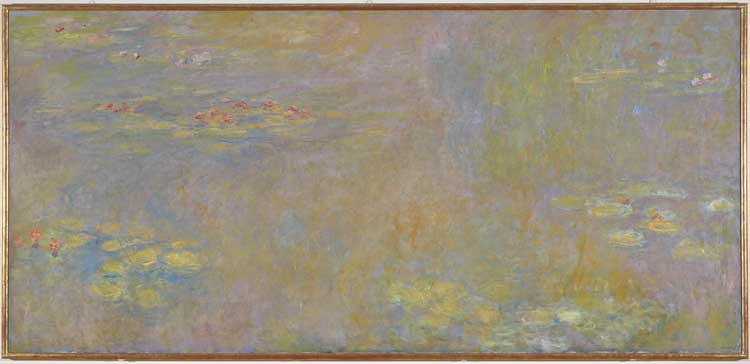
Claude Monet, Water-Lilies, after 1916. © The National Gallery, London.
Another example of a subject matter painted many times over is the Giverny pond with its waterlilies of Claude Monet. And one of these canvases is the National Gallery’s choice for peace. There is certainly something immersive, expansive and meditative about it – albeit with much less impact at the greatly reduced digital size. In contrast to the paintings selected for joy, the colours here, much like in the Titian, are muted and calming, and despite the artist describing the gentle swirls as “sheer madness”4, this garden certainly became his refuge in his later years, as his eyesight failed, and war raged.
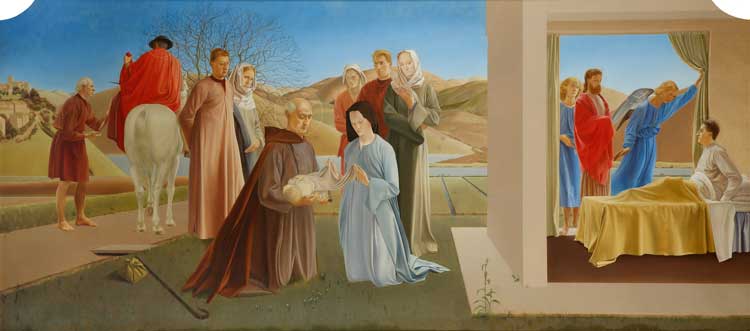
Winifred Knights, Scenes from the Life of Saint Martin of Tours, c1928–33. Oil (or possibly tempera) on canvas with glazing, 73 x 159.7 cm. Milner Memorial Chapel, Canterbury Cathedral. © The Estate of Winifred Knights.
The partner of this Monet is the much busier Scenes from the Life of Saint Martin of Tours by Winifred Knights (c1928-33), the reredos in the St Martin Chapel in Canterbury Cathedral. A friend of the artist, the painter David Young Cameron, noted in a letter to her that peace seemed to be an essential element for her to accomplish any work.5 Painted in the lull between two world wars, this work echoes the quattrocento style, moving away from the jagged-edged and fear-filled futurism of Knights’ The Deluge (1920), her metaphorical reflection on war. Fittingly for this comparison, the feast day of St Martin happens to be 11 November, the same day as the end of the first world war.
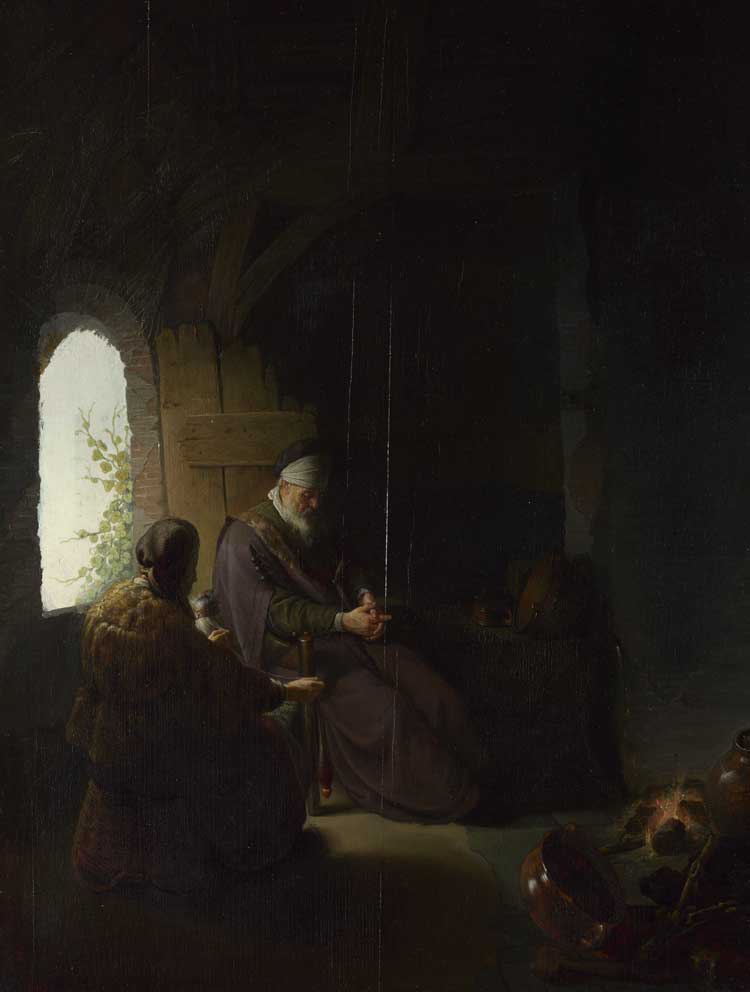
Rembrandt, Anna and the Blind Tobit, about 1630. © The National Gallery, London.
For patience, the exhibition pairs Rembrandt’s Anna and the Blind Tobit (c1630) (from the National Gallery) with Marguerite Gérard’s The Reader (c1817) (from the Barber Institute of Fine Arts, University of Birmingham). Both depict dark interiors and activities that demand patience, time and concentration: spinning and praying, while awaiting their son’s return, and reading, respectively. Regarding the paintings, too, demands time and patience – or “slow looking” in contemporary parlance – since each contains many details to be discovered on closer inspection of the shadows. In her catalogue essay on patience, senior research curator Susanna Avery-Quash writes: “In today’s secular and ever faster‐paced society, with increasingly sophisticated digital technologies, including mobile phones and round‐the‐clock ‘click and collect’ facilities, the value of patience has been seriously challenged.”6 This seems a somewhat ironic statement in a digital catalogue to accompany a virtual show, but she goes on to footnote the five‐minute art meditation videos, released by the National Gallery during the spring 2020 Covid‐19 lockdown, to promote mental wellbeing, as part of its “slow programming”.7
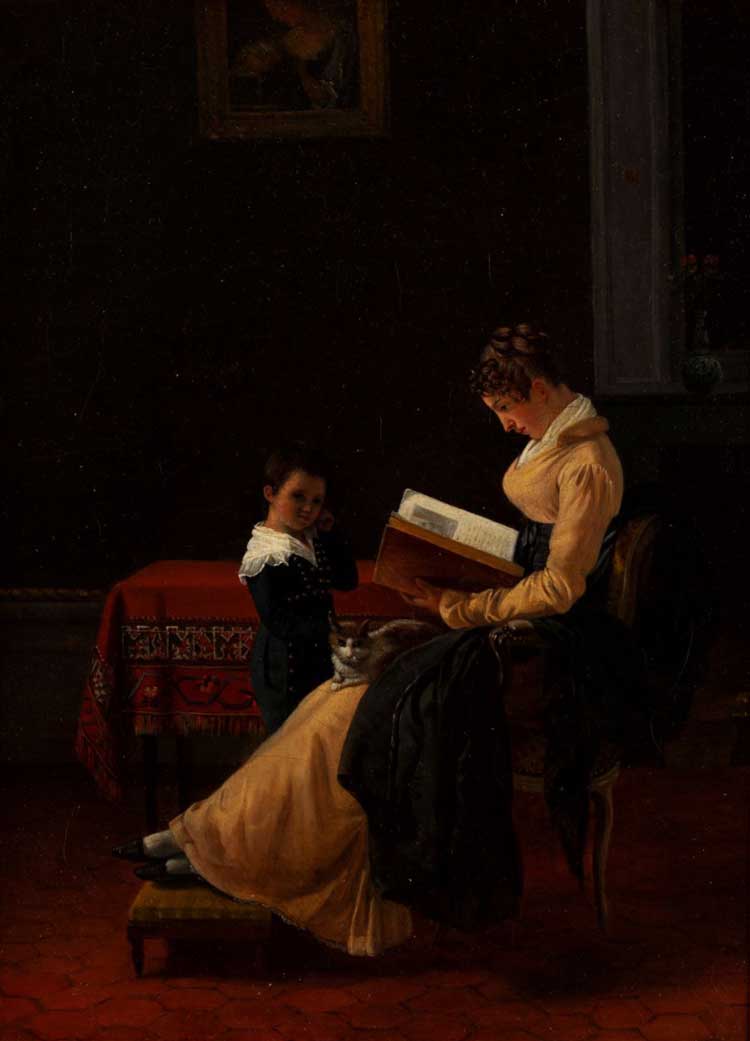
Marguerite Gérard, The Reader, about 1817. Oil on canvas, 32 x 24 cm. The Henry Barber Trust, The Barber Institute of Fine Arts, University of Birmingham.
While the light source in Rembrandt’s painting is the open window, in Gérard’s it is presumably a candle or oil lamp, although with the way it falls all the way up the lady’s yellow dress (in the catalogue, it is referred to as pink – a discrepancy which, again, might be arising not so much down to my eyesight as to the digital translation?),8 as she sits with her head inclined and feet elevated on a footstool; on her concentrated face, which looks down on to her open book; on to the pages of this book; and also on to her young son’s white collar, as he stands looking – it seems – over at the viewer. It is a most beautiful work, and one I have not ever encountered in the flesh, but now certainly hope to – not least because of just how much is not visible online (despite the painting being not much larger itself, at just 32 × 24cm), including the craquelure (“endless maze of tiny surface cracks”9) and, as enumerated in the catalogue, “a little painting on the wall, which apparently depicts an adolescent girl setting a bird free but is positioned so high that it extends beyond the frame” and “the pattern on the blue‐and‐white Delftware vase displayed on an otherwise empty mantelpiece.”10 As the author continues: “Layers and nuances abound in this small oil painting”, and I feel as though I’m going to need to employ my own patience here, as I wait for these to be revealed when I make it to Birmingham.
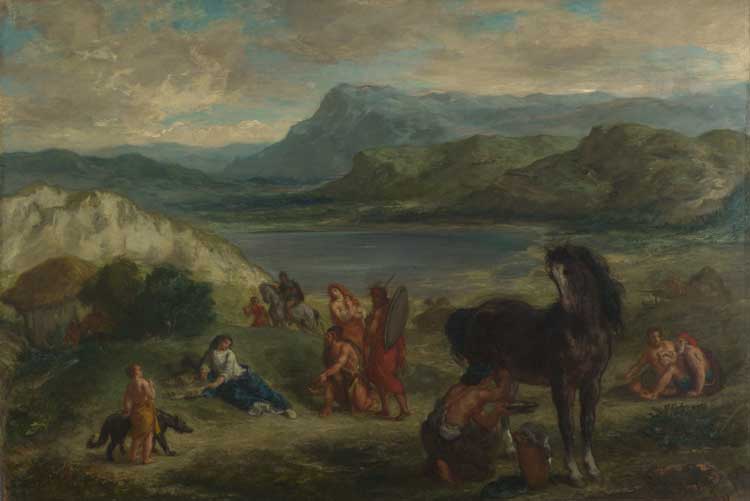
Eugène Delacroix, Ovid among the Scythians, 1859. © The National Gallery, London.
Next comes kindness, with Eugène Delacroix’s Ovid among the Scythians (1859) (from the National Gallery) and Christ Healing the Ear of Malchus (c1615-50) by an unnamed artist in the circle of Louis Finson (from the Bowes Museum). Kindness is a primary virtue in every religion, and one that has been written about by philosophers, poets and writers since time immemorial. This section is primarily interesting for using the paintings as a springboard for exploration of different types of kindness. Whereas the Delacroix depicts an act of communal kindness, for example, the other work shows an individual act of kindness whereby Jesus heals the ear of a slave, while being taken captive himself.
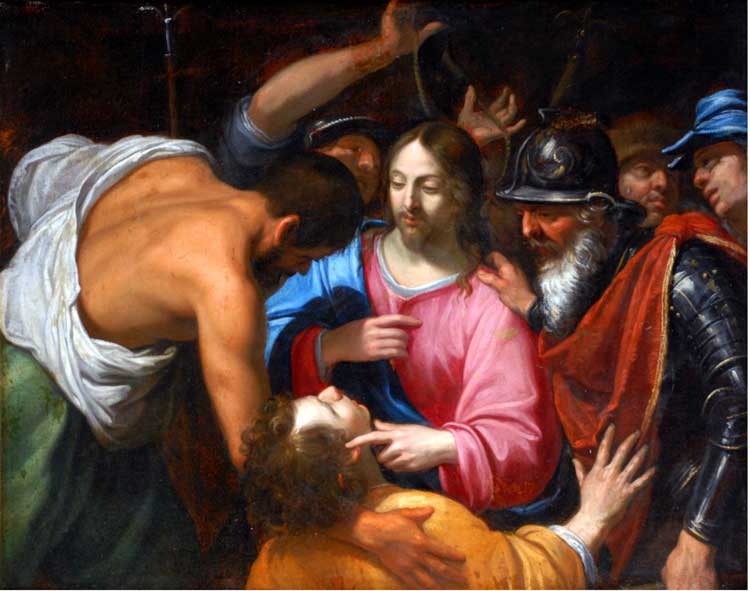
Circle of Louis Finson, Christ Healing the Ear of Malchus, c1615–1650. Oil on canvas, 100.5 x 130 cm. The Bowes Museum, Barnard Castle, Founders' Bequest.
Beyond this, the Methodist minister Graham A Cutler, in his essay,11 discusses the translation of the Greek term xrēstótēs (“divine kindness”), used in Galatians, as compared to the Hebrew term chesed, found 250 times in the Old Testament, but without a translation equivalent in English. It must be the former linguistics scholar in me, but I find things like this scintillating.
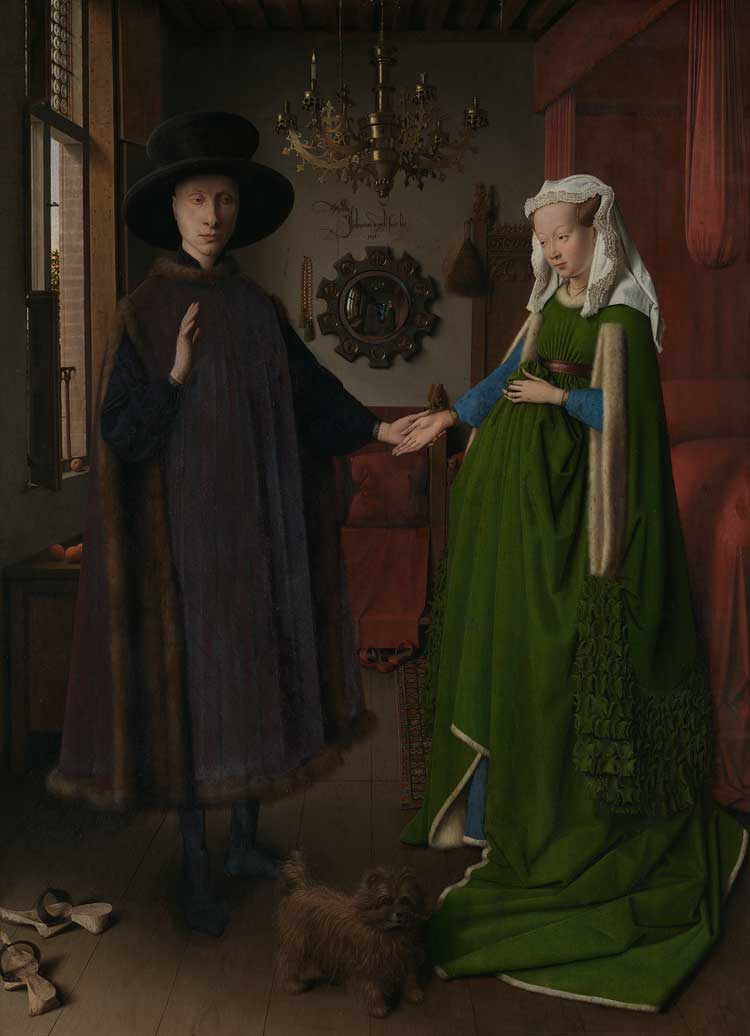
Jan van Eyck, The Arnolfini Portrait, 1434. © The National Gallery, London.
For generosity, we have the National Gallery’s Arnolfini Portrait (1434) by Jan van Eyck and the rather wonderful (another new one for me) Two Auld Wifies, Dundee (1982) by Ron Stenberg (from the McManus, Dundee). Whereas The Arnolfini Portrait has been much written and talked about, for all its nuanced iconography, which has led to its variously being read as an image of pregnancy, a betrothal, a marriage contract, and a memorial to Arnolfini’s first wife, who died shortly before the painting was commissioned, as Lepine says, the connection with the theme of generosity invites us to consider it with fresh eyes (although her essay sadly disappoints on this front).12

Ron Stenberg, Two auld wifies, Dundee, 1982. Oil on canvas, 94 x 121 cm. Collection of Dundee Art Galleries & Museums (Dundee City Council). Donated 2015 by the Artist, museum number 2015-61.
Stenberg’s painting is similarly a double portrait, and, although there are none of the fineries of Van Eyck’s, these figures also wear clothing that tells us much about their status and identity – more so than meets the eye, in fact. In her catalogue essay, Anna Robertson tells the remarkable tale of the identifying of this “pair of old women” as being just the one woman, Janet, visiting her son, Alexander, whose brown-and-white striped “skirt” is, in fact, the distinctively patterned pyjama bottoms of Dundee’s Royal Liff Hospital, where he was a long-term resident owing to his profound learning disabilities. The perfect example of true generosity comes at the end of this story when, despite having been ostracised during her lifetime, Janet left behind a substantial estate to establish a trust to benefit the people of Dundee.
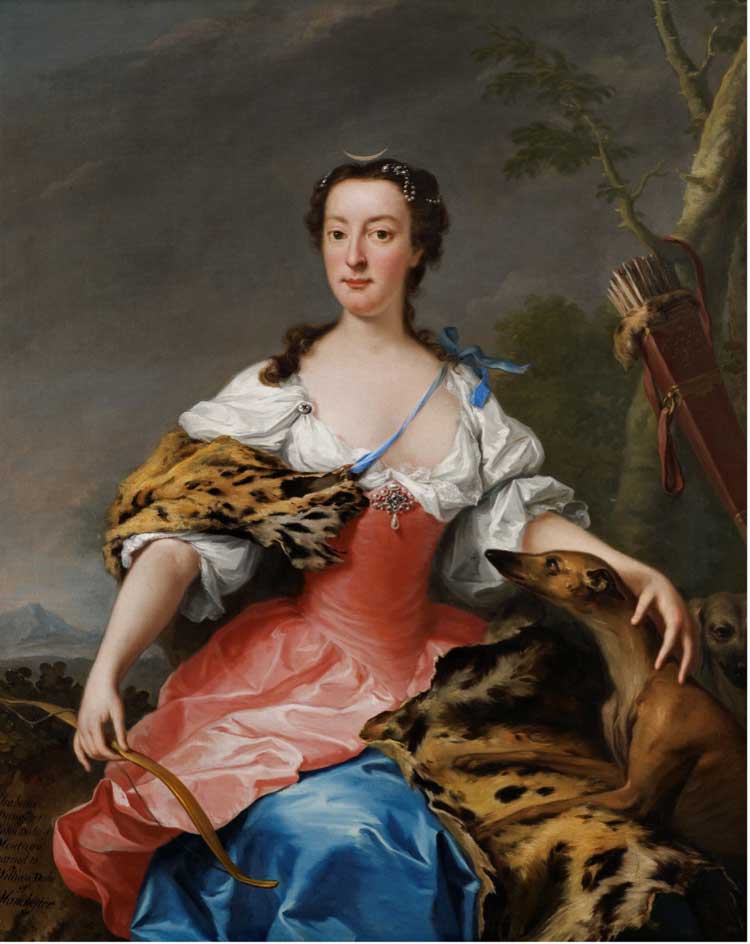
Andrea Soldi, Isabella, Duchess of Manchester, 1738. Oil on canvas, 127 x 101 cm. London, The Foundling Museum.
Orazio Gentileschi’s The Finding of Moses (1630s) (from the National Gallery) and Andrea Soldi’s Isabella, Duchess of Manchester (1738) (from the Foundling Museum) both start from the notion that faith is “the key to resisting despair” and “the foundation for hope”. Here, we really start to see how the nine fruits strengthen one another and might better be understood as seeds of one greater fruit, for which the primary description would be love.
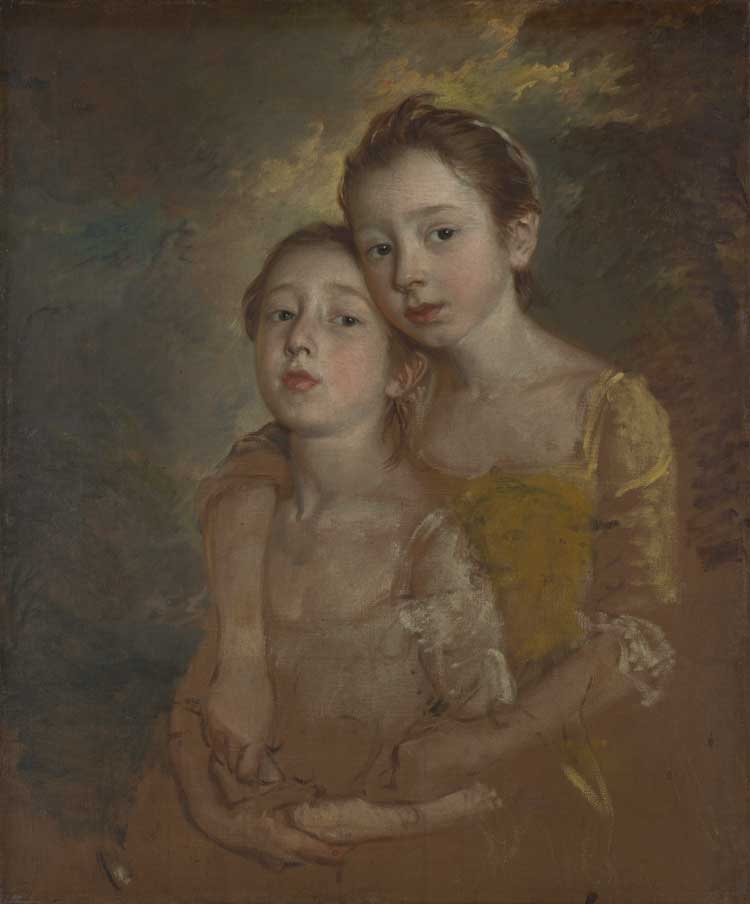
Thomas Gainsborough, The Painter's Daughters with a Cat, probably about 1760–1. © The National Gallery, London.
And the same might be said in the case of gentleness, where the National Gallery’s The Painter’s Daughters with a Cat (c1760-61) by Thomas Gainsborough is also a tender portrayal of sibling love, and the discussion accompanying Lizzie Jones’s Couple (2005) (from Southampton City Art Gallery) suggests that gentleness can be defined, among other things, as five of the “fruits” already discussed, namely joy, compassion (kindness), generosity, peace and love.13
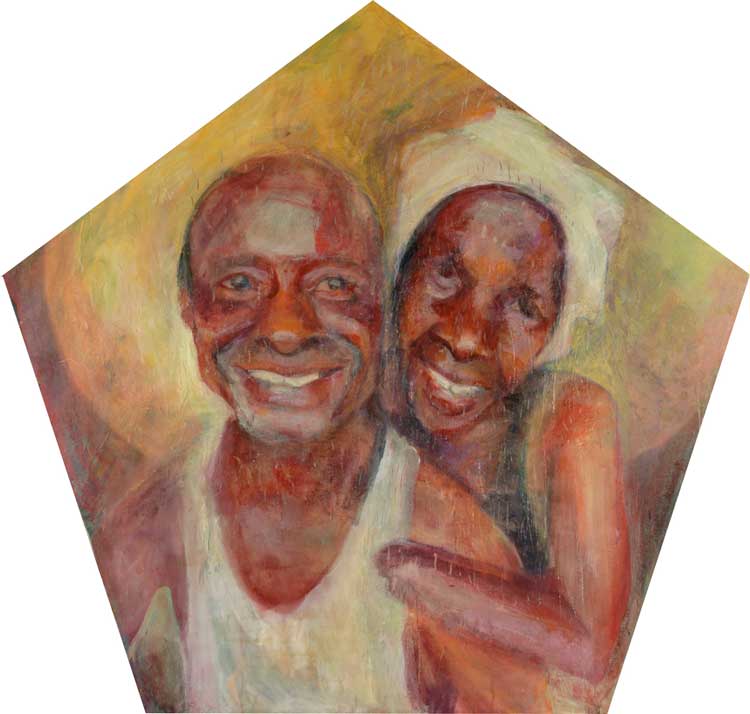
Lizzie Jones, Couple, 2005. Acrylic and wax on canvas, 107.3 x 112.8 cm. Southampton City Art Gallery.
The final fruitful pairing is for self-control, definitely something of a double-edged sword in my experience, but perhaps that is exactly why the chosen painting from the National Gallery’s collection is JMW Turner’s Rain, Steam and Speed – The Great Western Railway (1844), about which Lepine writes: “His painting doesn’t cast a deciding vote about whether the train is a sign of destruction or development, and the viewer ends up in the ambivalent zone of knowing that it’s both at once.”14
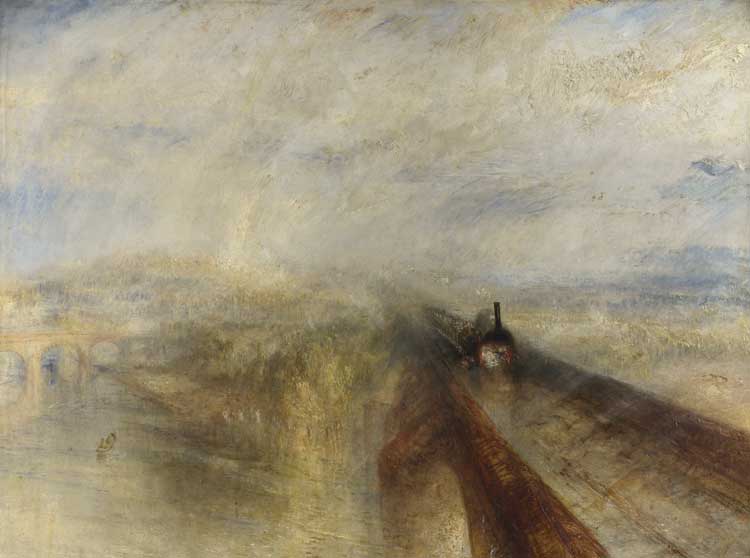
Joseph Mallord William Turner, Rain, Steam and Speed – The Great Western Railway, 1844. © The National Gallery, London.
The focus seems very much, however, to be on self-control in relation to man’s effect on the world and his environmental conscience. As Terah Walkup, curator of The Box, Plymouth, from where the partner work – Ben Hartley’s Devon Lane, Westlake (1968) – was selected, writes in her essay: “The quiet landscape of Devon Lane, Westlake, helps us contemplate self‐control in limiting the human impact on the landscape and consider our commitment to social and climate justice.”15 My instinctive response on seeing the Turner, however, is much more basic (and less socio-political): the whole image is a metaphor for a loss of self-control, both in terms of the driving of the rain itself; the collision of this biting water, falling from heavy clouds of condensation formed due to low pressure, with the red-hot heat of the steam vaporising under extremely high pressure from the engine; and the reckless speed at which the train is hurtling forth over the bridge. It all reeks of risk-taking, danger and unrestraint. Despite the palette of this painting, there is no greyness to the emotion and state expressed; this is all or nothing, black or white. While Hartley’s painting might, on the one hand, be read as contrasting with the Turner in its arcadian pastoral, there is, nonetheless, that same feeling of threat and impending danger due to the grey – almost black – heavy sky, emphasised by the curling smoke, almost horizontal (at the angle of steam from an engine), and the lanes so steep and bending, with brushstrokes perpendicular to those of their verges, that I feel vertiginous viewing it, as if I were hurtling my descent in a bobsleigh.
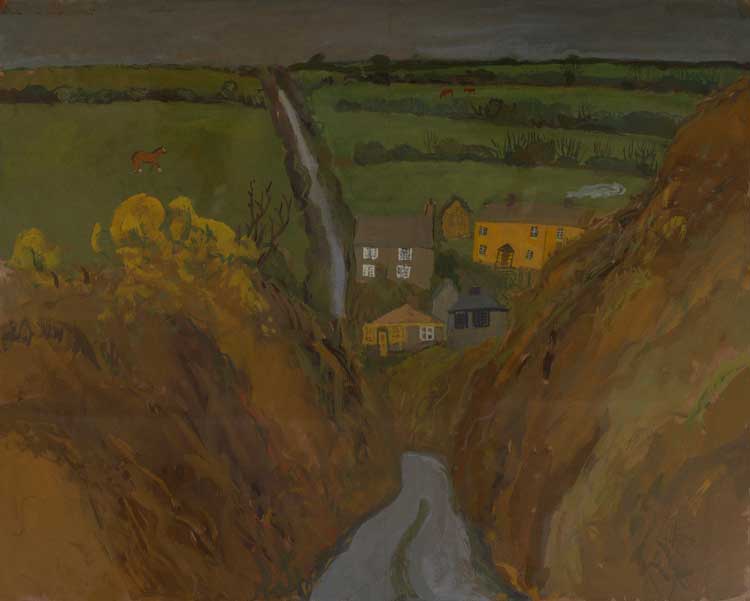
Ben Hartley, Devon Lane, Westlake, 1968. Gouache on paper, 71 cm x 57 cm. Plymouth, The Box. Gift of Bernard Samuels.
I am happy to finish the exhibition with this adventure, as it reminds me that sometimes the unguided, unbounded response to a painting is far more enjoyable than seeking the academic, disciplined reading. I am aware, also, as I come to the end of this essay, that I feel very much like a student in search of the latter, completing an assignment, for which I have spent hours holed up in the library researching, first and foremost considering ideas, with the odd illustration thrown in here and there. In no sense do I feel as if I have been to an exhibition, nor that I have had an encounter with any works of art. That visceral response has, for the most part, been lacking. I’m not saying that this is necessarily a wholly bad thing, as I have enjoyed the learning experience, and I’m certainly taking things away from it. Also, as I’ve noted, there are at least two paintings I didn’t know previously which are now on my bucket list to see in the flesh in a gallery. Therefore, as I set out at the beginning, if I am to judge the success of Fruits of the Spirit on its merits per se, then it scores pretty highly, but, if the criteria are to include its accomplishment as an alternative or equivalent to an afternoon spent visiting an in-person exhibition, then sadly, for me, there is no contest – this virtual experience is not even in the same ballpark.
• The Fruits of the Spirit digital catalogue can be accessed here.
References
1. The Letters by Vincent van Gogh, https://vangoghletters.org, no. 93.
2. Frank Auerbach: Paintings and Drawings, 1954-2001 by Catherine Lampert, exhibition catalogue, Royal Academy of Arts, London, 2001, page 15.
3. Joy by Jasmin Topalusic and Ruanna Brook with members of New Art Studio, in Fruits of the Spirit: Art from the Heart, digital exhibition catalogue, The National Gallery, London, 2022.
4. Mad Enchantment: Claude Monet and the Painting of the Water Lilies by Ross King, published by Bloomsbury, 2017, page 130.
5. Letter from David Young Cameron to Winifred Knights, 12 December 1940, private collection. Cited in Peace by Sacha Llewellyn, in Fruits of the Spirit: Art from the Heart, digital exhibition catalogue, The National Gallery, London, 2022.
6. Patience by Susanna Avery‐Quash, in Fruits of the Spirit: Art from the Heart, digital exhibition catalogue, The National Gallery, London, 2022.
7. See https://www.slowartday.com/slow‐looking‐meditations‐with‐the‐national‐gallery/.
8. Patience by Helen Cobby, in Fruits of the Spirit: Art from the Heart, digital exhibition catalogue, The National Gallery, London, 2022.
9. Ibid.
10. Ibid.
11. Kindness by Graham A Cutler, in Fruits of the Spirit: Art from the Heart, digital exhibition catalogue, The National Gallery, London, 2022.
12. Generosity by Ayla Lepine, ibid.
13. Gentleness by Lizzie Jones, Jemma Craig and some Quaker ‘Friends’ of Southampton, ibid.
14. Self-control by Ayla Lepine, ibid.
15. Self-control by Terah Walkup, ibid.